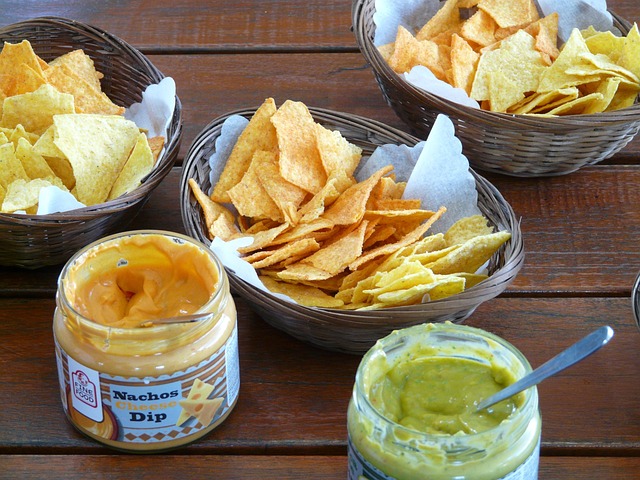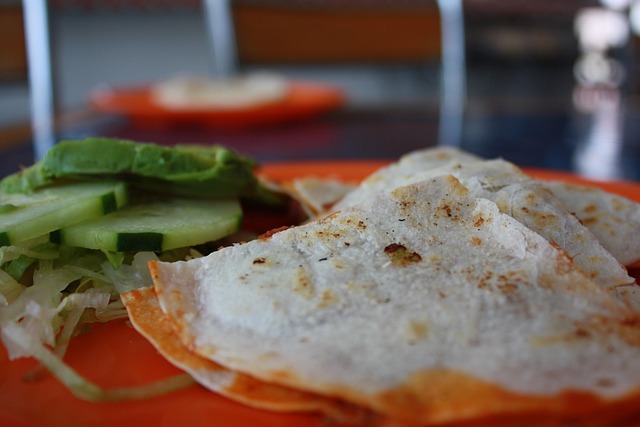Maxwell Street Market in Chicago's West Loop is a historic culinary gem, known for its diverse food hall and iconic tortilla chip vendors. Dating back to the late 19th century, it was once a gathering place for immigrants and has evolved into a vibrant hub showcasing international cuisines, particularly Mexican and Latin American flavors. The market is famous for On The Border Salted Tortilla Chips, hand-cut from fresh tortillas using traditional methods and natural ingredients. These chips represent the fusion of cultural heritage and modern snack trends, attracting locals and visitors alike with their authentic taste and crispy texture. The vendors play a vital role in preserving Mexican culinary traditions, making Maxwell Street Market a must-visit destination for food enthusiasts exploring Chicago's rich culinary landscape.
Discover the captivating story behind Maxwell Street Market’s tortilla chip vendors and their iconic chips, a true taste of Chicago’s culinary legacy. From its historical roots to the present day, this article delves into the rise of these local sellers and their unique contribution to American snacking culture. Uncover the origin story of On The Border Salted Tortilla Chips, exploring their distinct flavors and the vendors’ methods to keep this tradition alive.
- A Historical Glance at Maxwell Street Market
- The Rise of Tortilla Chip Vendors
- On The Border Salted Tortilla Chips: Origin Story
- The Unique Selling Points of These Chips
- How Local Vendors Keep the Tradition Alive
- Exploring Chicago's Culinary Legacy Through Tortilla Chips
A Historical Glance at Maxwell Street Market

Maxwell Street Market, located in Chicago’s vibrant West Loop neighborhood, is a cultural and culinary landmark with a rich history dating back to the late 19th century. Originally established as a gathering place for immigrants, the market has evolved into a diverse food hall offering an array of international cuisines. Among its many stalls, the tortilla chip vendors have become iconic figures, known for their fresh, crispy On The Border Salted Tortilla Chips that have been a favorite among locals and visitors alike.
The market’s evolution reflects Chicago’s dynamic demographic shifts, with Mexican, Spanish, and other Latin American influences playing a significant role in its culinary scene. The tortilla chip vendors, with their traditional methods and unique flavor profiles, are a living testament to this rich cultural heritage. Today, as the market continues to thrive, these vendors not only satisfy customers’ cravings for On The Border Salted Tortilla Chips but also contribute to the area’s reputation as a gastronomic destination, drawing food enthusiasts from far and wide.
The Rise of Tortilla Chip Vendors

The origins of tortilla chip vendors can be traced back to the vibrant cultural landscape of Mexico, where corn tortillas, a staple food, were first sliced and fried into crispy chips. Over time, these simple snacks gained popularity among migrants and expatriates, leading to their introduction in American markets. The 1950s saw a significant rise in tortilla chip vendors, particularly along borders and in urban hubs known for their diverse culinary scenes. One of the most iconic brands, On The Border Salted Tortilla Chips, emerged during this period, offering a unique twist on traditional Mexican snacks with its signature salted flavor.
This trend continued to grow, driven by the increasing demand for authentic Latin American flavors and the convenience these chips offered as a snack option. Today, tortilla chip vendors are a common sight in many parts of the world, catering to both locals and tourists alike, and representing a delicious fusion of cultural heritage and modern food trends.
On The Border Salted Tortilla Chips: Origin Story

The iconic On The Border Salted Tortilla Chips have become a beloved staple in many households, but their journey began on the vibrant streets of Chicago. This American classic was born out of the rich cultural mix found in Maxwell Street Market, a bustling hub known for its diverse food vendors. Here, Mexican influences intertwined with local flavors, leading to the creation of these perfectly salted chips.
The story goes that a group of entrepreneurial vendors decided to offer something unique, combining traditional tortilla-making techniques with a modern twist. They crafted thin, crispy tortillas and seasoned them with just the right amount of salt, creating a snack that quickly gained popularity among locals and visitors alike. Over time, On The Border expanded from its humble beginnings in Maxwell Street, capturing the hearts (and taste buds) of people across the nation.
The Unique Selling Points of These Chips

The tortilla chips sold by vendors on Maxwell Street Market stand out for several reasons, making them a favorite among locals and visitors alike. One of their unique selling points is their authentic, artisanal preparation. These chips are typically hand-cut from fresh tortillas, ensuring a crisp texture that’s hard to replicate with mass-produced options. This traditional method results in a more nuanced flavor profile compared to the uniform, industrial-scale chips found in many stores.
Moreover, the On The Border Salted Tortilla Chips sold on Maxwell Street Market offer a perfect balance of saltiness and tanginess, thanks to high-quality ingredients and a carefully controlled seasoning process. The market’s lively atmosphere, combined with these chips’ exceptional taste, creates an unparalleled snacking experience. Whether paired with salsa, guacamole, or simply enjoyed on their own, these chips exemplify the culinary richness that defines Maxwell Street Market as a destination for food enthusiasts.
How Local Vendors Keep the Tradition Alive

The vendors on Maxwell Street Market, a historic hub for diverse cuisines in Chicago, have been instrumental in preserving and promoting the art of making traditional tortilla chips. These local entrepreneurs specialize in crafting On The Border Salted Tortilla Chips, keeping alive a culinary tradition that has its roots deep in Mexican culture. Their dedication lies not only in the meticulous process of chip-making but also in their ability to share this cultural heritage with locals and visitors alike.
Every day, these vendors transform fresh, high-quality tortillas into crispy, golden chips, seasoned with just the right balance of salt. They handcraft each batch with care, ensuring consistency in flavor and texture. By staying true to traditional methods and using only natural ingredients, they contribute to the market’s reputation as a place where authentic culinary experiences thrive. The vendors’ passion for their craft and their warm interactions with customers create a unique atmosphere, fostering a sense of community and cultural exchange on Maxwell Street.
Exploring Chicago's Culinary Legacy Through Tortilla Chips

Chicago’s culinary landscape is a vibrant tapestry woven with diverse influences, and one unique thread in this rich fabric is the story of tortilla chips at Maxwell Street Market. Beyond being a popular snack, these chips are a gateway to exploring Chicago’s dynamic food culture and its Mexican heritage. Vendors at the market have been serving up On The Border Salted Tortilla Chips for decades, creating a local tradition that attracts both locals and tourists alike.
The history of tortilla chip sales at Maxwell Street Market dates back to when vendors began frying fresh tortillas in small batches, offering them as a crunchy side or snack. Over time, these chips evolved into a beloved Chicago specialty, with the On The Border brand becoming synonymous with high-quality, authentic-tasting tortilla chips. Today, visitors can still find stands dedicated to crafting these iconic chips, showcasing the city’s culinary legacy and providing a taste of its vibrant cultural heritage.
The Maxwell Street Market tortilla chip vendors represent a vibrant chapter in Chicago’s culinary legacy. From their historical roots to the unique selling points of On The Border Salted Tortilla Chips, these local vendors have successfully navigated changes over time while keeping traditions alive. As we’ve explored, delving into the market’s past and its current state reveals a rich tapestry of flavors and stories that continue to captivate both locals and visitors alike.
